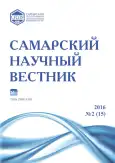Альгофлора среднего течения реки Зарафшан и ее взаимосвязь с индикаторно-сапробными видами
- Авторы: Ташпулатов Й.Ш.1
-
Учреждения:
- Самаркандский сельскохозяйственный институт
- Выпуск: Том 5, № 2 (2016)
- Страницы: 63-66
- Раздел: 03.02.00 – общая биология
- URL: https://journal-vniispk.ru/2309-4370/article/view/22059
- DOI: https://doi.org/10.17816/snv20162113
- ID: 22059
Цитировать
Полный текст
Аннотация
Изучены таксономические, флористические и индикаторно-сапробные особенности альгофлоры среднего течения реки Зарафшан, проведен сравнительный экологический анализ. Исследование проведено на 10 наблюдательных точках, распределенных по течению реки. Эти точки выбраны по расположению таких загрязняющих источников реки, как каналы, крупные коллекторы, сточные воды бытовых и промышленных источников крупных городов. Выявлено, что в реке имеется 331 вид и разновидность водорослей. Они относятся к 81 роду, 38 семействам, 16 порядкам, 11 классам и 5 отделам. Из них 97 видов и разновидностей являются индикаторно-сапробными водорослями. В первых трех наблюдательных точках экологические условия почти одинаковы. В этих пунктах определено 119 видов и разновидностей, из них 37 видов являются индикаторно-сапробными. Средний сапробный индекс – 1,27; α-олигосапробы, класс – 2, разряд – 2b. Более чистая вода в 4–7 наблюдательных пунктах реки, здесь определено 200 видов, из них 56 видов считается индикаторно-сапробными. Средний сапробный индекс – 1,61; β¹-мезосапроб, класс – 3, разряд – 3a, вода достаточно чистая. На 8–10 наблюдательных пунктах выявлено всего 125 видов, из них 44 вида считается индикаторно-сапробными видами. Средний сапробный индекс достиг 1,84; β¹-мезосапроб, класс – 3, разряд – 3a, вода достаточно чистая. По течению реки постепенно повышается сапробный индекс, сапробный уровень водорослей и загрязнение воды.
Полный текст
Открыть статью на сайте журналаОб авторах
Йигитали Шавкатиллаевич Ташпулатов
Самаркандский сельскохозяйственный институт
Автор, ответственный за переписку.
Email: yigitali_t1981@mail.ru
ассистент кафедры плодоовощеводства и виноградарства
Узбекистан, СамаркандСписок литературы
- Алимжанова Х.А. Изменение санитарного состояния воды канала Бозсу Ташкентского оазиса под антропогенным воздействием // Эколого-экономические основы безопасной жизнедеятельности: Материалы 2-й всероссийской конференции Ч. 1. Новосибирск, 1993. С. 104–106.
- Алимжанова Х.А. Закономерности распределения водорослей водоемов реки Чирчик и их значение в определении эколого-санитарного состояния водоемов: автореф. дис. … д-ра биол. наук. Ташкент, 2005. 49 с.
- Алимжанова Х.А., Шайимкулова М.А. Альгофлора реки Акбууры и ее значение в оценке качества воды. Ташкент, 2008. 125 с.
- Голлербах М.М., Полянский В.И. Определитель пресноводных водорослей СССР. Вып. 1. Общая часть. Пресноводные водоросли и их изучение. М.: Советская наука, 1951. 350 с.
- Жукинский В.Н., Оксиюк О.П., Олейник Г.Н., Кошелова С.И. Принципы и опыт построения экологической классификации качества поверхностных вод суши // Гидробиологический журнал. 1981. Т. XVII. № 12. С. 38–49.
- Стерлягова И.Н., Патова Е.Н. Водоросли как индикаторы состояния водоемов в бассейнах реки Кожим и Малый Паток (Национальный парк «Югыд Ва») // Проблемы современной альгологии: Материалы Всероссийской школы-семинара. Уфа: РИЦ БашГУ, 2008. С. 127–130.
- Kolkwitz R., Marsson M. Oecologie der tierischen saprobien // Int. Rev. Hydrobiol., 1909. Vol. 11. P. 113.
- Pantle R., Buck N. Die biolodische Uberwachund der Gewasser und Darstellund der Ergebnisse // Gas-und Wasser-fash. 1955. Bd. 96. 18. 604 p.
- Sladecek V. System of water quality from the biological point of view // Arch. Hydrobiol. Erboeb. 1973. Bd. 7. P. 210–218.
- Sramer-Husek R. Zurbiologischen charakteristik der hoheren Saprobitat s stufen // Arch. Hydrobiol. 1956. Vol. 53. № 3. P. 162–163.
Дополнительные файлы







